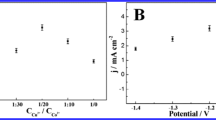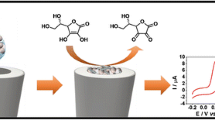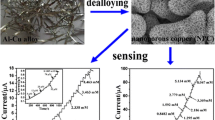Abstract
Copper nanoparticles (Cu-NPs) were incorporated into chitosan hydrogel to form a film on the surface of a glassy carbon electrode (GCE) leading to a sensing element for D-arabinitol with excellent oxidative catalytic activity. The electrochemical response to D-arabinitol was studied by cyclic voltammetry and differential pulse voltammetry. Operational parameters affecting the response were examined and optimized, and a simple and sensitive method was established for the determination of D-arabinitol. Response is linear in the concentration range from 10 μmol·L−1 to 10 mmol·L−1, and the limit of detection is 1.0 μmol·L−1. The method may be combined with separation techniques in order to analyze for the ratio of D- and L-arabinitol which is a diagnostic marker for candidiasis.




Similar content being viewed by others
References
Nett JE, Andes D (2008) Review of techniques for diagnosis of catheter-related Candida biofilm infections. Curr Fungal Infect Rep 2:237–243
Walsh TJ, Chanock SJ (1998) Diagnosis of invasive fungal infections: advances in nonculture systems. Curr Clin Top Infect Dis 18:101–153
Hui M, Cheung SW, Chin ML, Chu KC, Chan RCY, Cheng AFB (2004) Development and application of a rapid diagnostic method for invasive Candidiasis by the detection of D-/L-arabinitol using gas chromatography/mass spectrometry. Diagn Microbiol Infec Dis 49:117–123
Yeo SF, Wong B (2002) Current status of nonculture methods for diagnosis of invasive fungal infections. Clin Microbiol Rev 15:465–484
Christensson B, Sigmundsdottir G, Larsson L (1999) D-arabinitol: a marker for invasive candidiasis. Med Mycol 37:391–396
Kiehn TE, Bernard EM, Gold JWM, Armstrong D (1979) Candidiasis: detection by gas-liquid chromatography of D-arabinitol, a fungal metabolite, in human serum. Science 206:577–580
Roboz J, Suzuki R, Holland JF (1980) Quantification of arabinitol in serum by selected ion monitoring as a diagnostic technique in invasive candidiasis. J Clin Microbiol 12:594–602
Wojnarowski W, Jaquet H, Glauser MP (1979) Arabinitol, a metabolite of Candida albicans. Experientia 35:945, (Abstract)
Yeo SF, Zhang Y, Schafer D, Campbell S, Wong B (2000) A rapid, automated enzymatic fluorometric assay for determination of D-arabinitol in serum. J Clin Microbiol 38:1439–1443
Hino M, Tatsumi N, Yamane T, Ohta IK, Takubo T, Yabuuchi M (2000) New enzymatic method for determining D-arabinitol in serum. J Basic Microbiol 40:363–368
Morrison CJ, Hurst SF, Reiss E (2003) Competitive binding inhibition enzyme-linked immunosorbent assay that uses the secreted aspartyl proteinase of Candida albicans as an antigenic marker for diagnosis of disseminated candidiasis. Clin Dlagn Lab Immunol 10:835–848
Bernard EM, Christiansen LJ, Tsang SF, Kiehn TE, Armstrong D (1981) Rate of arabinitol production by pathogenic yeast species. J Clin Microbiol 14:189–194
Gold JW, Wong B, Bernard EM, Kiehn TE, Armstrong D (1983) Serum arabinitol concentrations and arabinitol/creatinine ratios in invasive candidiasis. J Infect Dis 147:504–513
Stradomska Z, Mielniczuk TJ (2002) Gas chromatographic determination of D- / L-arabinitol ratio in healthy Polish children. J Chromatogr B 773:175–181
Salonen JH, Rimpiläinen M, Lehtonen L, Lehtonen OP, Nikoskelainen J (2001) Measurement of the D-arabinitol/L-arabinitol ratio in urine of neutropenic patients treated empirically with amphotericin B. Eur J Clin Microbiol Infect Dis 20:179–184
Voegel PD, Baldwin RP (1996) Electrochemical detection with copper electrodes in liquid chromatography and capillary electrophoresis. Am Lab 28(39–40):42–5
Hughes S, Johnson DC (1983) Triple-pulse amperometric detection of carbohydrates after chromatographic separation. Anal Chim Acta 149:1–10
Prabhu SV, Baldwin RP (1989) Electrocatalysis and detection of amino sugars, alditols, and acidic sugars at a copper-containing chemically modified electrode. Anal Chem 61:2258–2263
Safina GR, Medyantseva EP, Fomina OG, Glushko NI, Budnikov GK (2005) Amperometric enzyme immunosensors for diagnosing certain infectious diseases. J Anal Chem 60:546–552
Safina GR, Medyantseva EP, Bazarnova ON, Glushko NI, Budnikov GK (2006) Determination of bacterial antigens using a multichannel immunoenzyme amperometric sensor. J Anal Chem 61:912–916
Katz E, Willner I, Wang J (2004) Electroanalytical and bioelectroanalytical systems based on metal and semiconductor nanoparticles. Electroanalysis 16:19–44
Murray RW (2008) Nanoelectrochemistry: metal nanoparticles, nanoelectrodes, and nanopores. Chem Rev 108:2688–2720
Male KB, Hrapovic S, Liu YL, Wang DS, Luong JHT (2004) Electrochemical detection of carbohydrates using copper nanoparticles and carbon nanotubes. Anal Chim Acta 516:35–41
Colon LA, Dadoo R, Zare RN (1993) Determination of carbohydrates by capillary zone electrophoresis with amperometric detection at a copper microelectrode. Anal Chem 65:476–481
Schwarz MA, Galliker B, Fluri K, Kappes T, Hauser PT (2001) A two-electrode configuration for simplified amperometric detection in a microfabricated electrophoretic separation device. Analyst 126:147–151
Budnikov GK, Evtugin GA, Budnikova YG, Al’fonsov VA (2008) Chemically modified electrodes with amperometric response in enantioselective analysis. J Anal Chem 63:2–12
Luo MZ, Baldwin RP (1995) Characterization of carbohydrate oxidation at copper electrodes. J Electroanal Chem 387:87–94
Miller B (1969) Split-ring disk study of the anodic processes at a copper electrode in alkaline solution. J Electrochem Soc 116:1675–1680
Ashworth Y, Fairhurst D (1977) The anodic formation of Cu2O in alkaline solutions. J Electrochem Soc 124:506–517
Fletcher S, Barradas RG, Porter JD (1978) The anodic oxidation of copper amalgam and polycrystalline copper electrodes in LiOH solution. J Electrochem Soc 125:1960–1968
Abd El Haleem SM, Ateya BG (1981) Cyclic voltammetry of copper in sodium hydroxide solutions. J Electroanal Chem 117:309–319
Pyun CH, Park SM (1986) In situ spectroelectrochemical studies on anodic oxidation of copper in alkaline solution. J Electrochem Soc 133:2024–2030
Burke LD, Ahem MJG, Ryan TG (1990) An investigation of the anodic behavior of copper and its anodically produced oxides in aqueous solutions of high pH. J Electrochem Soc 137:553–561
Zhao J, Wang F, Yu JJ, Hu SS (2006) Electro-oxidation of glucose at self-assembled monolayers incorporated by copper particles. Talanta 70:449–454
Feng D, Wang F, Chen ZL (2009) Electrochemical glucose sensor based on one-step construction of gold nanoparticle-chitosan composite film. Sensor Actuat B-Chem 138:539–544
Luo XL, Xu JJ, Du Y, Chen HY (2004) A glucose biosensor based on chitosan–glucose oxidase–gold nanoparticles biocomposite formed by onestep electrodeposition. Anal Biochem 334:284–289
Larew LA, Johnson DC (1989) Concentration dependence of the mechanism of glucose oxidation at gold electrodes in alkaline media. J Electroanal Chem 262:167–182
Adzic RR, Hsiao MW, Yeager EB (1989) Electrochemical oxidation of glucose on single crystal gold surfaces. J Electroanal Chem 260:475–485
Vassilyev YB, Khazova OA, Nikolaeva NN (1985) Kinetics and mechanism of glucose electrooxidation on different electrode-catalysts: Part II. Effect of the nature of the electrode and the electrooxidation mechanism. J Electroanal Chem 196:127–144
Ocón P, Alonso C, Celdrán R, Velasco JG (1986) Study of the electrooxidation of n-propanol on an Au electrode in basic medium. J Electroanal Chem 206:179–196
Castro-Luna AM, de Mele MFL, Arvia AJ (1992) The electro-oxidation of glucose on microcolumnar gold electrodes in different neutral solutions. J Electroanal Chem 323:149–162
Acknowledgements
The authors gratefully acknowledge the financial support from the National Natural Science Foundation of China (Nos 60801020, 90817103, 20775055, 30973672) and start-up funding for ZC’s Luojia chair professorship of Wuhan University (Nos. 306276216, 306271159) and the Important National Science and Technology Specific Projects (No. 2009ZX09301-14). Authors would like to thank Prof. Shengshui Hu, Department of Chemistry, Wuhan University, for his support on the CHI instrument.
Author information
Authors and Affiliations
Corresponding author
Rights and permissions
About this article
Cite this article
Wang, F., Liao, Y., Ren, Y. et al. A novel method for D-arabinitol determination based on a nano-structured sensing film by one-step electrodeposition. Microchim Acta 170, 9–15 (2010). https://doi.org/10.1007/s00604-010-0368-3
Received:
Accepted:
Published:
Issue Date:
DOI: https://doi.org/10.1007/s00604-010-0368-3




